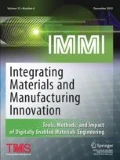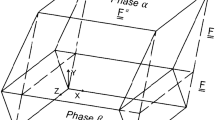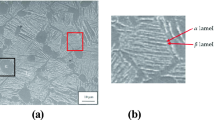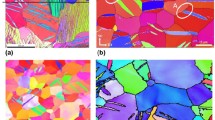Abstract
Large and highly textured regions, referred to as macrozones or microtextured regions, with sizes up to several orders of magnitude larger than those of the individual grains, are found in dual-phase titanium alloys as a consequence of the manufacturing process route. These macrozones have been shown to play a critical role in the failure of titanium alloys, specifically being linked to crack initiation and propagation during cyclic loading. Modeling microstructures containing macrozones using continuum-level formulations to describe the elastic–plastic deformation at the grain scale, i.e., crystal plasticity, poses computational challenges due to the large size of the macrozones, which in turn prevents the use of modeling approaches to understand their deformation behavior. In this work, a crystal plasticity-based modeling approach is implemented to model macrozones in Ti–6Al–4V. Further, to overcome the large computational expense associated with modeling microstructures containing macrozones, a modeling strategy is introduced based on a crystal plasticity description for the macrozone with a reduced-order model for the surrounding aggregate combining anisotropic elasticity and J2 plasticity, based on crystal plasticity-based training data. This modeling approach provides a grain-level description of deformation within macrozones using elastic–plastic continuum simulations, which has often been overlooked. Finally, the reduced-order model is used to investigate the strain localization within the microstructure and the effect of varying the misorientation tolerance on the localization of plastic strain within the macrozones.










Similar content being viewed by others
References
Le Biavant K, Pommier S, Prioul C (2002) Local texture and fatigue crack initiation in a Ti–6Al–4V titanium alloy. Fatigue Fract Eng Mater Struct 25:527–545. https://doi.org/10.1046/j.1460-2695.2002.00480.x
Gey N, Bocher P, Uta E, Germain L, Humbert M (2012) Texture and microtexture variations in a near-α titanium forged disk of bimodal microstructure. Acta Mater 60:2647–2655. https://doi.org/10.1016/j.actamat.2012.01.031
Uta E, Gey N, Bocher P, Humbert M, Gilgert J (2009) Texture heterogeneities in αp/αs titanium forging analysed by EBSD-Relation to fatigue crack propagation. J Microsc 233:451–459. https://doi.org/10.1111/j.1365-2818.2009.03141.x
Bridier F, Villechaise P, Mendez J (2008) Slip and fatigue crack formation processes in an α/β titanium alloy in relation to crystallographic texture on different scales. Acta Mater 56:3951–3962. https://doi.org/10.1016/j.actamat.2008.04.036
Bantounas I, Dye D, Lindley TC (2010) The role of microtexture on the faceted fracture morphology in Ti–6Al–4V subjected to high-cycle fatigue. Acta Mater 58:3908–3918. https://doi.org/10.1016/j.actamat.2010.03.036
Humbert M, Germain L, Gey N, Bocher P, Jahazi M (2006) Study of the variant selection in sharp textured regions of bimodal IMI 834 billet. Mater Sci Eng A 430:157–164. https://doi.org/10.1016/j.msea.2006.05.047
Semiatin SL, Kinsel KT, Pilchak AL, Sargent GA (2013) Effect of process variables on transformation-texture development in Ti–6Al–4V sheet following beta heat treatment. Metall Mater Trans A 44:3852–3865. https://doi.org/10.1007/s11661-013-1735-6
Echlin MP, Stinville JC, Miller VM, Lenthe WC, Pollock TM (2016) Incipient slip and long range plastic strain localization in microtextured Ti–6Al–4V titanium. Acta Mater 114:164–175. https://doi.org/10.1016/j.actamat.2016.04.057
Bandyopadhyay R, Mello AW, Kapoor K, Reinhold MP, Broderick TF, Sangid MD (2019) On the crack initiation and heterogeneous deformation of Ti–6Al–4V during high cycle fatigue at high R ratios. J Mech Phys Solids 129:61–82. https://doi.org/10.1016/j.jmps.2019.04.017
Book TA, Sangid MD (2016) Strain localization in Ti–6Al–4V Widmanstätten microstructures produced by additive manufacturing. Mater Charact 122:104–112. https://doi.org/10.1016/j.matchar.2016.10.018
Britton TB, Birosca S, Preuss M, Wilkinson AJ (2010) Electron backscatter diffraction study of dislocation content of a macrozone in hot-rolled Ti–6Al–4V alloy. Scr Mater 62:639–642. https://doi.org/10.1016/j.scriptamat.2010.01.010
Goh C-H, Neu RW, McDowell DL (2003) Crystallographic plasticity in fretting of Ti–6AL–4V. Int J Plast 19:1627–1650. https://doi.org/10.1016/S0749-6419(02)00039-6
Mayeur JR, McDowell DL (2007) A three-dimensional crystal plasticity model for duplex Ti–6Al–4V. Int J Plast 23:1457–1485. https://doi.org/10.1016/j.ijplas.2006.11.006
Zhang M, Zhang J, McDowell DL (2007) Microstructure-based crystal plasticity modeling of cyclic deformation of Ti–6Al–4V. Int J Plast 23:1328–1348. https://doi.org/10.1016/j.ijplas.2006.11.009
Bridier F, McDowell DL, Villechaise P, Mendez J (2009) Crystal plasticity modeling of slip activity in Ti–6Al–4V under high cycle fatigue loading. Int J Plast 25:1066–1082. https://doi.org/10.1016/j.ijplas.2008.08.004
Hasija V, Ghosh S, Mills MJ, Joseph DS (2003) Deformation and creep modeling in polycrystalline Ti–6Al alloys. Acta Mater 51:4533–4549. https://doi.org/10.1016/S1359-6454(03)00289-1
Deka D, Joseph DS, Ghosh S, Mills MJ (2006) Crystal plasticity modeling of deformation and creep in polycrystalline Ti-6242. Metall Mater Trans A 37:1371–1388. https://doi.org/10.1007/s11661-006-0082-2
Dunne FPE, Rugg D, Walker A (2007) Lengthscale-dependent, elastically anisotropic, physically-based hcp crystal plasticity: application to cold-dwell fatigue in Ti alloys. Int J Plast 23:1061–1083. https://doi.org/10.1016/j.ijplas.2006.10.013
Kapoor K, Sangid MD (2018) Initializing type-2 residual stresses in crystal plasticity finite element simulations utilizing high-energy diffraction microscopy data. Mater Sci Eng A 729:53–63. https://doi.org/10.1016/j.msea.2018.05.031
Kapoor K, Yoo YSJ, Book TA, Kacher JP, Sangid MD (2018) Incorporating grain-level residual stresses and validating a crystal plasticity model of a two-phase Ti–6Al–4V alloy produced via additive manufacturing. J Mech Phys Solids 121:447–462. https://doi.org/10.1016/j.jmps.2018.07.025
Zhang Z, Jun T-S, Britton TB, Dunne FPE (2016) Determination of Ti-6242 α and β slip properties using micro-pillar test and computational crystal plasticity. J Mech Phys Solids 95:393–410. https://doi.org/10.1016/j.jmps.2016.06.007
Zheng Z, Balint DS, Dunne FPE (2016) Dwell fatigue in two Ti alloys: an integrated crystal plasticity and discrete dislocation study. J Mech Phys Solids 96:411–427. https://doi.org/10.1016/j.jmps.2016.08.008
Cuddihy MA, Stapleton A, Williams S, Dunne FPE (2017) On cold dwell facet fatigue in titanium alloy aero-engine components. Int J Fatigue 97:177–189. https://doi.org/10.1016/j.ijfatigue.2016.11.034
Salem AA, Shaffer JB, Kublik RA, Wuertemberger LA, Satko DP (2017) Microstructure-informed cloud computing for interoperability of materials databases and computational models: microtextured regions in Ti alloys. Integr Mater Manuf Innov 6:111–126. https://doi.org/10.1007/s40192-017-0090-7
Pilchak AL, Li J, Rokhlin SI (2014) Quantitative comparison of microtexture in near-alpha titanium measured by ultrasonic scattering and electron backscatter diffraction. Metall Mater Trans A 45:4679–4697. https://doi.org/10.1007/s11661-014-2367-1
Pilchak AL, Shank J, Tucker JC, Srivatsa S, Fagin PN, Semiatin SL (2016) A dataset for the development, verification, and validation of microstructure-sensitive process models for near-alpha titanium alloys. Integr Mater Manuf Innov 5:14. https://doi.org/10.1186/s40192-016-0056-1
Woodffield AP, Gorman MD, Corderman RR, Sutliff JA, Yamrom B (1995) Effect of microstructure on dwell fatigue behavior of Ti-6242, In: Titan.’95 Sci Technol
Venkatesh V, Tamirisa S, Sartkulvanich J, Calvert K, Dempster I, Saraf V, Salem AA, Rokhlin S, Broderick T, Glavicic MG, Morton T, Shankar R, Pilchak A (2016) Icme of microtexture evolution in dual phase titanium alloys. In: Proceedings of the 13th World Conference on Titanium. John Wiley & Sons, pp 1907–1912. https://doi.org/10.1002/9781119296126.ch319
Mayeur JR, McDowell DL, Neu RW (2008) Crystal plasticity simulations of fretting of Ti–6Al–4V in partial slip regime considering effects of texture. Comput Mater Sci 41:356–365. https://doi.org/10.1016/j.commatsci.2007.04.020
Hall EO (1951) The deformation and ageing of mild steel: III discussion of results. Proc Phys Soc Sect B. 64:747. https://doi.org/10.1088/0370-1301/64/9/303
Petch NJ (1953) The cleavage strength of polycrystals. J Iron Steel Inst 174:25–28. https://doi.org/10.1007/BF01972547
Bandyopadhyay R, Prithivirajan V, Sangid MD (2019) Uncertainty quantification in the mechanical response of crystal plasticity simulations. JOM. https://doi.org/10.1007/s11837-019-03551-3
Groeber MA, Jackson MA (2014) DREAM.3D: a digital representation environment for the analysis of microstructure in 3D. Integr Mater Manuf Innov 3:5. https://doi.org/10.1186/2193-9772-3-5
Abaqus Documentation (2017)
Dunne F, Petrinic N (2005) Introduction to computational plasticity. Oxford University Press, Oxford
Kearns JJ (1965) Thermal expansion and preferred orientation in Zircaloy (LWBR Development Programe)
Sangid MD (2013) The physics of fatigue crack initiation. Int J Fatigue 57:58–72. https://doi.org/10.1016/j.ijfatigue.2012.10.009
Antolovich SD, Armstrong RW (2014) Plastic strain localization in metals: origins and consequences. Prog Mater Sci 59:1–160. https://doi.org/10.1016/j.pmatsci.2013.06.001
Lütjering G, Williams JC (2007) Titanium. Springer, Berlin
Dunne FPE, Walker A, Rugg D (2007) A systematic study of hcp crystal orientation and morphology effects in polycrystal deformation and fatigue. Proc R Soc A Math Phys Eng Sci 463:1467–1489. https://doi.org/10.1098/rspa.2007.1833
Zhang K, Yang KV, Huang A, Wu X, Davies CHJ (2015) Fatigue crack initiation in as forged Ti–6Al–4V bars with macrozones present. Int J Fatigue 80:288–297. https://doi.org/10.1016/j.ijfatigue.2015.05.020
Zheng Z, Balint DS, Dunne FPE (2016) Discrete dislocation and crystal plasticity analyses of load shedding in polycrystalline titanium alloys. Int J Plast 87:15–31. https://doi.org/10.1016/j.ijplas.2016.08.009
Acknowledgements
This work was financially supported by Pratt and Whitney. The authors would like to thank Dr. Vasisht Venkatesh (Materials and Processing Engineering, Pratt and Whitney) for insightful discussions and Dr. Tom Broderick (Materials Engineering at the Air Force Research Laboratory) for suggestions that improved this work.
Author information
Authors and Affiliations
Corresponding author
Ethics declarations
Conflict of interest
KK and MDS declare no conflicts of interests, while RN and VK are employees of Pratt & Whitney.
Rights and permissions
About this article
Cite this article
Kapoor, K., Noraas, R., Seetharaman, V. et al. Modeling Strain Localization in Microtextured Regions in a Titanium Alloy: Ti–6Al–4V. Integr Mater Manuf Innov 8, 455–467 (2019). https://doi.org/10.1007/s40192-019-00159-y
Received:
Accepted:
Published:
Issue Date:
DOI: https://doi.org/10.1007/s40192-019-00159-y




